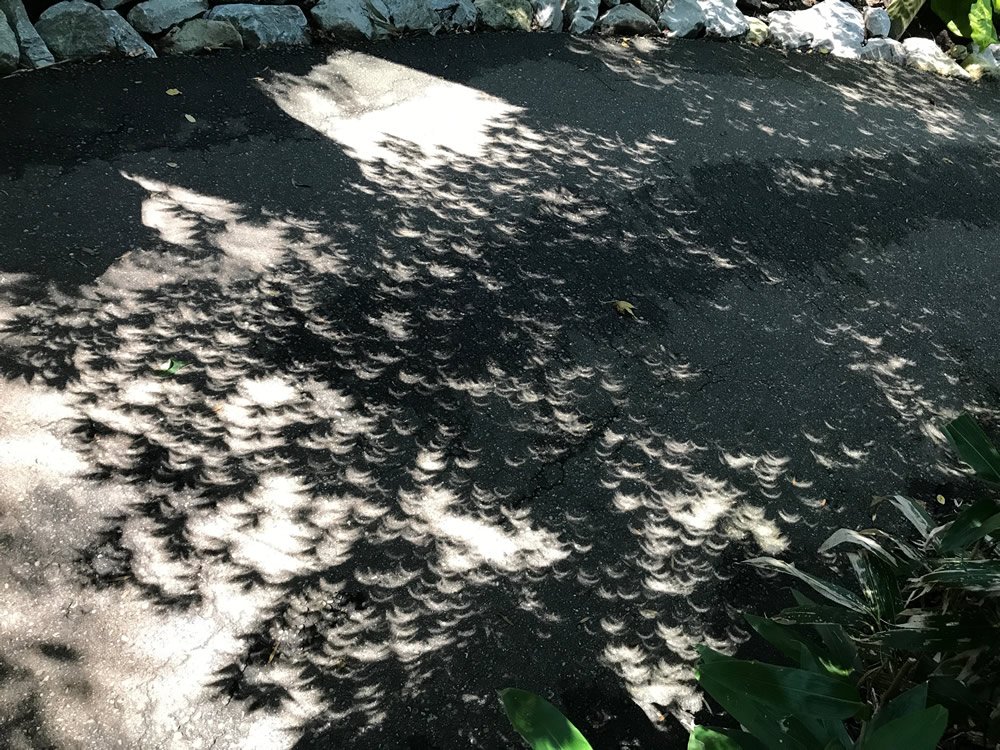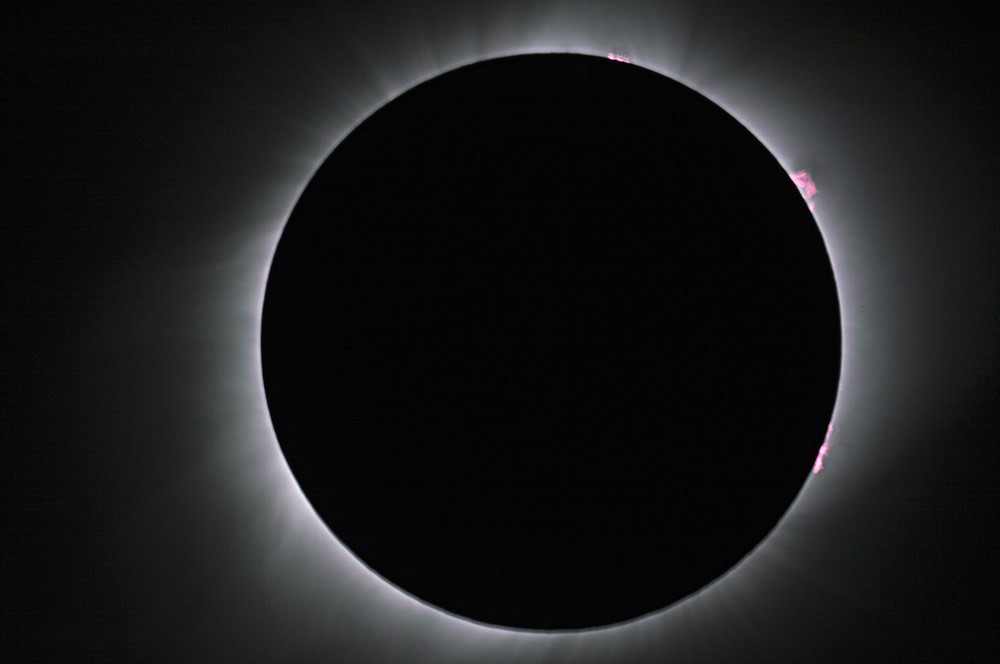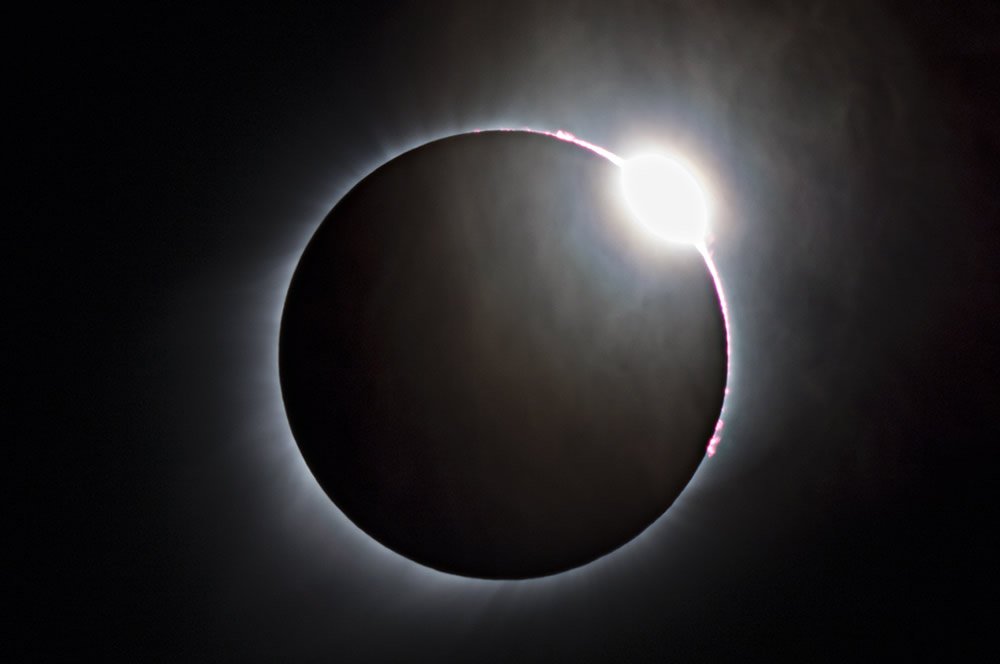
Thoughts on the Recent Solar Eclipse
Now that “The Great American Eclipse” is over, it’s time to reflect on the experience and report what we saw. I was wrong about at least one thing. I’ve said for years that the total solar eclipse I experienced in Arborg, Manitoba, on February 26, 1979, was the most incredible thing I had ever experienced. For lack of a better term, the totality of August 21, 2017, eclipsed that one.
The weather was good over most of the path of totality across the United States, encompassing parts of 12 states, from Oregon to South Carolina. I heard from one friend in coastal South Carolina who reported that he was clouded out. However, in the rest of South Carolina, the weather was good. I heard from people in Georgia, Tennessee, and Kentucky, reporting that they had fine views of the eclipse. A friend in Kansas reported cloudy skies. However, another friend in Grand Island, Nebraska, reported clear skies and good photographs. In an airport coming home, I talked to a man who watched the eclipse in Idaho. In an unusual event, even the coast of Oregon saw clear enough skies that morning for people there to see the eclipse.
As I reported before, I was near Warm Springs, Oregon, just east of the Cascades, on a field trip organized by the Design Science Association of Portland. I want to especially thank Marianne Pike and her sister Becki for their hard work in organizing this trip. Because of the possibility of traffic jams on the few roads to the viewing site, we departed from a church in Sandy, Oregon, at 3:00 a.m. (the eclipse started a little past 9:00 a.m.). The drive time normally would be less than 90 minutes, but we didn’t want to take any chances. Plus, we rode a diesel bus that couldn’t make as good time as a car could. As we drove toward Sandy on US Highway 26 before 2:30 a.m., we saw many taillights ahead of us, but not too many headlights coming the other way. Though hardly a traffic jam, this continued the entire way once we were aboard the bus.
Reaching the Destination
We arrived at our destination about 4:30 a.m., when it was starting to get light. For something like this, I’d rather be very early than just a little late. Our viewing location was on a ranch on the Warm Springs Indian Reservation. Hundreds of thousands—perhaps more than a million—people poured into the eclipse path in Oregon. But being on generally inaccessible land, this location provided our group with privacy that many other locations did not afford. I understand that it was wall-to-wall people in many locations. The family that owned the ranch kindly let us use a spot in a horse pasture. Since we had to watch where we stepped, we didn’t start setting up until after sunrise. It was a lovely site, on a hill with good exposure to the east. The Deschutes River was in that direction, and we could see the opposite rim of its gorge a few miles away. That would be important later. There were several horses in the pasture. They were a bit curious, and some ventured near enough for some people in our party to pet them.
I pointed out to our group some interesting geology that I noticed. To the northwest there were exposed layers of sedimentary rock clearly visible in the near rim of the gorge. However, to the north, there was much basalt on the near rim and down its side. This was part of a lava flow. Even the hill we were on appeared to be a lava flow. I told our group that this was similar to what we see in parts of Grand Canyon. And both places tell a similar story. The sedimentary layers here and in Grand Canyon were laid down during the Genesis Flood. Both Grand Canyon and the Deschutes River Canyon were carved out catastrophically in a large local flood after the biblical world-wide Flood. Since the Deschutes River empties into the Columbia River, its gorge probably formed as part of the Great Missoula Flood that carved the Columbia River gorge. Grand Canyon formed when a large lake rapidly drained. Finally, volcanic eruptions sent lava over the rims of Grand Canyon and the Deschutes River canyon, lava that cooled and hardened into what we see today.
Preparing to View the Eclipse
Once we selected the site for viewing, we had to transport equipment from the bus to the observing sight. This included telescopes, cameras, extension cords, chairs, food, and coolers. Then there was the process of setting up. All of this went very well, so there was time to relax until the partial phase of the eclipse began a little past 9:00 a.m. The exact time was announced on an app. We had passed out special eclipse glasses, so everyone put them on and began to watch once the app said to. For a moment, several people were disappointed, because they didn’t see any part of the sun being blocked. I think I was the first to announce that I could see the start of the moon passing over the sun from the right. But, then, I was cheating—I was looking through the three-and-a-half inch Questar telescope at 50x, and everyone else was using just their eyes (with appropriate protective glasses or filters!). However, within a minute or so, everyone began to see it for themselves, and I began to hear approving sounds. We had about 80 minutes until totality.
As the partial phase progressed, I occasionally took photos through the telescope. We had been blessed with some very nice sunspots a few days before, and they made a fine addition to the scene. These probably were the best sunspots I had seen in nearly two years. We’re approaching minimum of the sunspot cycle, so such spots are getting rarer. (See the accompanying photo of the spots with the moon partly blocking the sun.)

Over the next hour, the anticipation built. Two of us held a white screen in the shade of some trees. The sun’s light passing through holes in the canopy of a tree usually produces many little spots on the ground. These amount to pin-hole images of the sun. Normally, they are round, because the sun is round. However, during a partial solar eclipse, the images are those of the partially eclipsed sun, so the images look like little crescents. Most of the people were happy to see these, but I must confess I was a bit disappointed. I think that the gaps in the canopies of deciduous trees are better than the juniper trees that we had. However, juniper trees appeared to be the only trees available in the pasture. There are plenty of deciduous trees at the Creation Museum, and many of my coworkers at work noticed these images of the sun on the sidewalk. Some even took photographs of them, such as this one taken by Joel Leineweber.

At least twenty minutes before totality, it was obvious that there was less light than normal. It was sort of like how things look late in the day with the sun low in the sky, or when there are thin clouds all over the sky. However, in those conditions, shadows cast by the sun are fuzzy and indistinct, if visible at all. If anything, our shadows were sharper than ever. That probably was because the part of the sun still visible was much smaller than normal. It added a subtle, eerie effect.
I saw Venus for several minutes before totality. A few other people did too, but many did not. It was a matter of knowing where to look. As we approached totality, we watched for shadow bands. We placed a white sheet on a fence and another on the ground in front of the fence. Shadow bands can be seen for a few minutes before and after totality. A few of us saw some very faint shadow bands, but mostly they were a no-show. We had some thin clouds, which may have hindered the visibility of shadow bands.
It was during the lead-up to totality than I began a live feed from my iPhone to the Answers in Genesis Facebook page. Judging by comments made on the Facebook page, many people were not impressed. First, after a few minutes, I turned the phone sideways. For some reason, I had a vague recollection that I was supposed to do that, and I felt bad that I had forgotten to do it. I need to learn not to pay attention to my vague recollections. Second, some people were annoyed with the low quality of the camera work. I wouldn’t argue with that. Others appeared to be annoyed by what I or others were saying on the video. However, this was supposed to be a field recording, showing people elsewhere what was going on and, most importantly, letting viewers hear the reactions of people watching the eclipse. My running around and speaking was for the benefit of the people with me, not the people watching the live feed. Eventually, I passed my phone off to someone else and eventually took the phone back myself. It’s a lot to ask anyone to spend all the time of totality making sure that the quality of the live feed was good. I apologize for the low quality, but please understand that I was juggling many responsibilities, and I had much to attend to, particularly when the two minutes of totality began. And I wanted to enjoy the eclipse myself. If anything, the mistakes I made illustrate the affect that the excitement of the moment has on people.
In the last minute before totality, everything rapidly grew much dimmer. An eerie look descended on everything. Finally, the app announced the beginning of totality, and it went dark in a matter of seconds. I and a few others leading the group shouted to look up. This was the cue to drop the eclipse glasses and drink in the experience. The first thing I saw was the huge corona around the sun. It extended out much farther than I remembered during the one previous total solar eclipse I had experienced, in Manitoba in 1979. It was brighter than I expected, with a noticeable extension to the upper left. Within the corona were many streamers that map out the magnetic field in the corona. The whole thing looked surreal, like a painting hoisted up into the sky. What had impressed me during the 1979 eclipse were the many bright red prominences around the perimeter of the sun, loops extending out into space. However, this eclipse had only a few modest prominences. I attempted photos of both the prominences and the inner corona. Unfortunately, many of my photos suffered from shutter shake (or what I call shutter shudder), vibrations from the shutter opening and closing on the camera. Still, as you can see, I got a few good photos.

I took time to explore other phenomena during the eclipse. While the sky was dark, near the horizon in all directions it was brighter, with an odd red/orange hue. That was from where sunlight was shining perhaps 35 miles away. I looked for stars. Venus was easy to see. I looked for Regulus, just to the left of the sun, but I couldn’t see it in the corona’s glare. I easily saw Sirius, the brightest star in the sky, as well as Procyon nearby. I looked for Castor and Pollux not far from Venus, but I didn’t see them. I also quickly glanced around for the stars of Orion, but to no avail. Perhaps those stars were obscured by slightly thicker clouds in their locations. I didn’t want to waste too much time on them if they weren’t readily visible, so I quickly gave up looking for them or other stars. Just before totality, we saw a bat fly past. And down the hill the horses were running around making noise right as totality ended. I don’t know what that was about. Oh, and the people in our party were hooting and hollering, so it’s not just animals that act weird.
End of Totality
Before we knew it, the app warned that totality was ending. Our two minutes were up. Sadly, we all looked away from the sun as brightness began to return. We looked to our left to see light chase the darkness up the wall of the other side of the gorge. Things began to return to normal. During totality, the air temperature dropped 9 or 13 degrees F, depending on which thermometer you trust. I prefer the lower temperature change, because that thermometer was in the shade the entire time. Keep in mind this was mid-morning, when the temperature ordinarily would be rising. If the eclipse had been midday, I’m sure the temperature change would have been greater. I continued to take some photos of the partial phases after totality. Reluctantly, we began to pack up. Our time (not) in the sun had ended.
I’ve asked people from my party to share their photos with me so that I can share them with you. I also asked friends elsewhere along the path of totality to send me their photos. So, here goes. Jebi Koilpillai took this wide-angle shot showing some members of our group and trees in the foreground with the eclipsed sun in the sky.

Jim Bonser, who was in Grand Island, Nebraska, took this photo of the diamond ring effect as totality ended.

It was no surprise that what I think was the best photo came from David Rives (just when I think my astronomy photos are getting pretty good, David sends me one, and I wonder why I bother.). David was in eastern Oregon. We had some thin clouds and some smoke from fires, but he reported his skies were excellent. This photo shows the stunning corona image that he took.

Still, this image doesn’t quite match what I saw. The photos never do. I think that is because our eyes respond very differently to light than cameras do. Cameras respond linearly, but our eyes respond logarithmically. This gives our eyes much greater dynamic range, compressing large differences in brightness. This allows us to see things in the corona that the camera cannot, at least with single images. It takes multiple images of various exposure to match the eye’s dynamic range, and then there is no way to combine them into a single image. Notice that the bright star Regulus shows up in David’s image. Unlike us, he could see Regulus with the naked eye.
Finally, Jebi took this candid photo of me as totality was ending.

The shot was candid, because I was so caught in the moment, I didn’t even know he was standing near me. The expression in my face and the look in my eyes capture the wonder and amazement of this eclipse. All of us agreed that this was one of the most incredible things we had ever experienced. It was so different from the 1979 eclipse. When is the next total solar eclipse? For the United States, it’s 2024, less than seven years away. Mark your calendars. However, I’m hooked. I may try to sneak off somewhere else in the world for an eclipse in the meantime.

Answers in Genesis is an apologetics ministry, dedicated to helping Christians defend their faith and proclaim the good news of Jesus Christ.
- Customer Service 800.778.3390
- © 2024 Answers in Genesis
